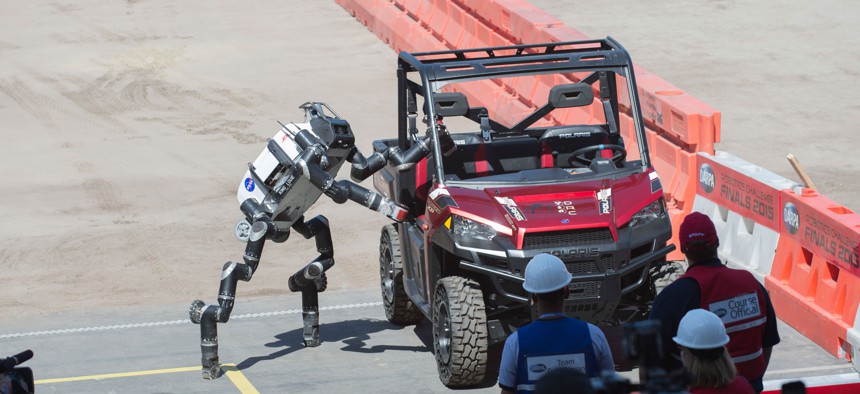
RoboSimian, a simian-inspired robot from the Jet Propulsion Labs, exits a vehicle during the Defense Advanced Research Projects Agency (DARPA) Robotics Challenge (DRC) June 5 in Pomona, Calif. U.S. Navy photo by John F. Williams
Will DARPA’s Disaster Robots Ever Go to War? Never Say Never
In the latest Grand Challenge, semi-autonomous machines pushed the state of the art for humanoid robots.
LOS ANGELES — As a packed crowd watched from the grandstand, a 443-pound robot named CHIMP ground its rubberized feet against the pavement and began to climb a set of stairs at the Los Angeles County Fairgrounds. Heaving back and forth in the afternoon sun, the 4-foot-11-inch robot struggled slowly upwards, finally mounting a platform to cheers from the crowd. Tony Stentz, the Carnegie Mellon University professor who led the effort to build CHIMP, hailed his team’s ability to “turn what could have been a disaster into a success.”
Dealing with disaster was, in fact, the theme of the DARPA Robotics Challenge , a two-day competition in which 23 teams —from the United States, South Korea, Japan, Germany, Italy, and Hong Kong—set their humanoid robots to eight tasks of the kind that rescue workers might have to do in an emergency. “It’s about trying to advance the technology for disaster response,” said Gill Pratt, the program manager for the Robotics Challenge at the Pentagon’s Defense Advanced Research Projects Agency, or DARPA. But it’s not hard to envision future versions of these robots showing up on a battlefield in years to come, and some believe that could turn these roboticists’ success into a disaster.
Still, that’s some time away. The Fairgrounds course, modeled roughly on the Fukushima-Daiichi nuclear power plant that melted down in 2011, in no way resembled, say, the mountainous battlegrounds of Afghanistan. “The terrain at the competition is benign, to be honest,” said Ronald Arkin, a robotics professor at the Georgia Institute of Technology. “The land is flat; there are relatively few impediments to walking, except at the last part of the course; and the environment is fairly well characterized”—meaning that the robots could be programmed in advance with a pretty good idea of what the course would look like.
Moreover, the robots were given lots of help from their human builders as they tackled the tasks. In one event, the robots drove dune buggies down a dirt path around traffic barricades, hopped out, and opened a door.
But once they were inside, DARPA engineers working in a garage nearby scrambled the wireless communications so that the teams received updates from their robots only every 30 seconds. “They’re making sure nobody’s back there with a joystick,” David Kortenkamp, CEO of Houston-based TracLabs, explained as his teammates tested their robot’s perception, coded in green and blue dots, in their control room. Ultimately, the robots were on their own for much of the time—turning valves, drilling around chunks of drywall, walking or pushing through piles of rubble, and climbing up stairs, using predictive 3-D modeling where a human would use senses and a highly evolved brain.
(See also: The 9 Strangest Flying Robots from the World’s Biggest Drone Show )
Most robots in the tournament, such as the Boston Dynamics ATLAS used by seven teams, carry at least three computers and more than a million lines of code. They can’t learn from their mistakes or perceive their surroundings as well as their sentient operators, and must be programmed to understand their environment down to each millimeter. That makes them ill-suited to Afghanistan’s rugged hills, where split-second reactions mean everything.
So robots like ATLAS and CHIMP could be more than a decade away from any real action, depending upon whom you ask. But robots could prove effective much earlier for simpler tasks such as counting buried land mines, according to Alexander Leonessa, an associate professor of mechanical engineering at Virginia Tech. He added that he wasn’t interested in developing droids for military objectives.
But experts outside of the E-ring believe the Pentagon may already be heading that way. “Remember, the ‘D’ in DARPA stands for defense,” said Peter Singer, a strategist and senior fellow at the New America Foundation. “Their job is to support military activities.” Indeed, most of the robots at this grand finale of the Robotics Challenge earned their invitations by navigating an urban obstacle course that resembled areas of Iraq and Afghanistan.
South Korean Champions
At the championship event, CHIMP’s heroics weren’t quite enough to win. South Korea’s Team KAIST and its DRC-Hubo robot took home the $2 million grand prize by finishing all eight tasks in 44 minutes and 28 seconds, besting the favored “Running Man,” a 6-foot-2-inch ATLAS robot piloted by the Florida Institute for Human and Machine Cognition. CHIMP came in third, clearing the course just five minutes shy of the one-hour time limit.
DARPA’s Pratt admitted he was surprised that six teams managed to garner at least seven points out of a possible eight on the first day. “Our greatest concern was that the contest was going to be too easy, or too hard,” he said.
The fact that a South Korean team prevailed could actually have strategic value to the Defense Department, by providing a wakeup call to large U.S. contractors that have been reluctant to get into robotics. Lockheed Martin was the only major corporation to participate in the competition. Although the Defense Department sponsored the competition, private industry will have the most say about how humanoid robots develop, particularly Google, which purchased ATLAS maker Boston Dynamics in December 2013.
Building such robots is expensive; Team KAIST’s first-place prize might not even cover their insurance bill, much less the other development costs. And DARPA itself spent around $95 million to set up and hold the Challenge’s preliminary and final events.
What did the Defense Department get for its money? At very least, the show succeeded as a great public outreach event, attracting views and interest from around the globe. Organizers like Pratt expressed surprise at the fan reaction. “I don’t cheer for my laptop, but people cheer for these [robots],” he said. “Running Man” proved a particularly effective showman, displaying an exaggerated fist pump after completing the course.
Lurching Toward Robot Autonomy
The event was meant to push a new area of robotic autonomy, just as the DARPA 2004 and 2005 Grand Challenges jumpstarted the development of self-driving cars. But the move toward greater autonomy in military robotics is, in many ways, as controversial as the use of armed drones.
In 2013, an informal poll released by the University of Massachusetts-Amherst revealed that a majority of Americans disapprove of using autonomous robots in combat. They’re not alone. More than 50 NGOs, including Human Rights Watch, the International Committee for Robot Arms Control, and the Campaign to Stop Killer Robots, have called for an international ban on autonomous weapons. The proposal has the backing of the U.N.’s special rapporteur, Christof Heyns.
One of the leading proponents of a ban, Mark Gubrud, a physicist and adjunct professor at the University of North Carolina, thinks that autonomous weapons could actually make things worse for non-combatants. “What I’m really worried about is putting too much faith in machines because we think they’re smart,” he said. “We’re not going to know what's going on with those systems and we're not going to know what to expect.”
The Pentagon already uses lethal autonomous weapons: anti-tank mines, fire-and-forget systems, the Navy’s Aegis weapon system, Patriot missiles, and cruise missiles. Singer estimates that 80 countries have already invested in lethal robotics. But are humanoid robots marching us toward a dark, science fiction-like future? Georgia Tech’s Arkin said he didn’t believe so. “I don't think the military wants a Terminator. We want a system that can do this under human supervision.”
But Arkin doesn’t think skeptics should be so quick to rule out the benefits of battlefield robots: “We may be able to design systems which can potentially outperform human warfighters with respect to international humanitarian law.” To that end, he has proposed the development of a programmable code of human-rights conduct for these machines.
With robots struggling to make their way through the obstacle course, we’re still figuring out just what their role might be. “Do you expect them to do what a Green Beret can do?” Singer asked. “No, but [robots] will play a role in the next major war.”
South Korea's Team KAIST and its DRC-Hubo robot, shown here on the course in fast-motion, took home the $2 million prize. (Video courtesy of DARPA)




